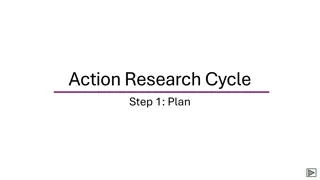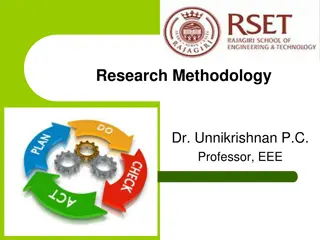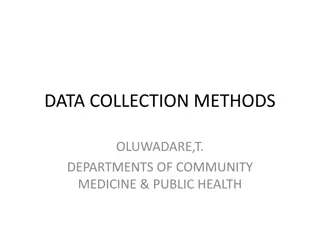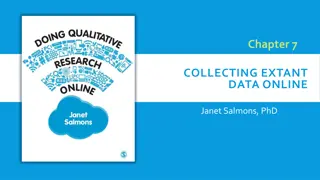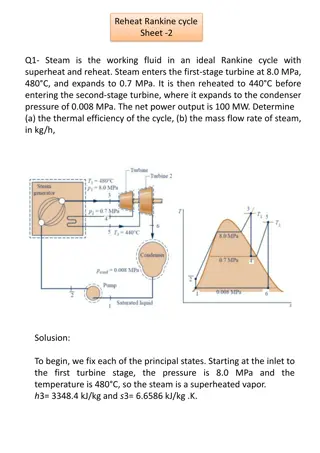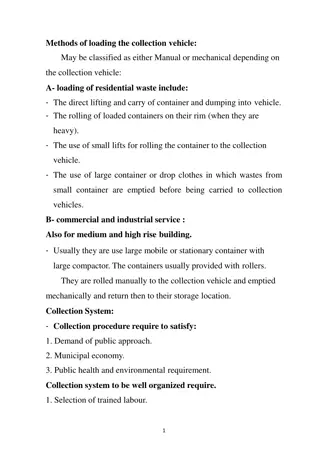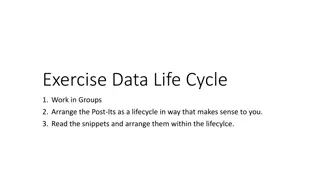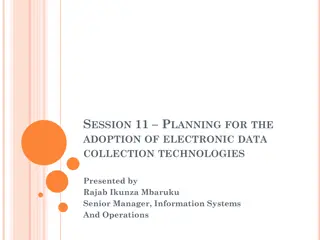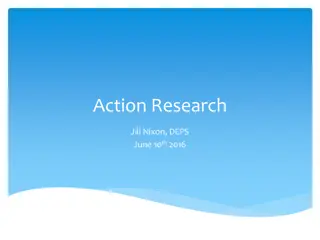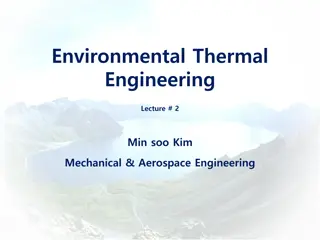Action Research Cycle: Step 2 - Data Collection Methods
In the second step of the Action Research Cycle, teachers collect qualitative and quantitative data using methods such as field notes, research journals, interviews, surveys, checklists, rubrics, and more. Understanding the importance of data collection in the classroom is crucial for effective teaching strategies and student learning. Explore various data collection techniques to enhance your research and teaching practices.
Download Presentation

Please find below an Image/Link to download the presentation.
The content on the website is provided AS IS for your information and personal use only. It may not be sold, licensed, or shared on other websites without obtaining consent from the author.If you encounter any issues during the download, it is possible that the publisher has removed the file from their server.
You are allowed to download the files provided on this website for personal or commercial use, subject to the condition that they are used lawfully. All files are the property of their respective owners.
The content on the website is provided AS IS for your information and personal use only. It may not be sold, licensed, or shared on other websites without obtaining consent from the author.
E N D
Presentation Transcript
ACTION RESEARCH CYCLE STEP 2: ACT (1)
Presentation outline Presentation outline Act or Action which is the Step 2 of Action research cycle Qualitative and Quantitative data collection methods Qualitative data collection methods: Field notes Research journals Video & Audio recordings Conferences Interviews
Translation of main words and phrases in the Translation of main words and phrases in the presentation presentation Qualitative data collection methods Quantitative data collection methods Try out any teaching strategy Field notes Research journals Conferences , ( ) Report cards , , Standardized tests ( , , , )
Step 2: Act Step 2: Act Teachers collect data to understand their teaching and students learning: what is happening in the classroom. In the second step of the Action research cycle, teachers put the plan into action. In other words, they collect the data that they have planned or try out any teaching strategy. There are two types of data collection methods Qualitative Quantitative *Select only two to four types of data to collect to keep your research focused. *Find or adapt the methods that best suit your research question or your teaching situation.
Qualitative Field notes Research journals Conferences Interviews Video & Audio recordings Surveys (open response) Checklists (open-ended) Written assignments Projects Lesson plans Meeting notes Portfolios Quantitative Checklists Rubrics Surveys Teacher made tests/quiz Standardized tests Attitude and rating scales Self-assessments
Data collection methods: Field Notes Field Notes Field notes are the written observations of what you see taking place in your classroom. Field notes can be three types: thick descriptions during This type of field notes involves taking notes while teaching takes place. You can do thick descriptions when you observe another teacher s classroom. quick notes during It is possible to make quick notes while teaching. notes and reflections after Teachers prefer to record their observations after the lesson or at the end of the day. *Read more about Field notes (pages 68-70) in the supplementary readings. Johnson, A. (2012). A short guide to action research (4th ed.). Allyn and Bacon.
Data collection methods: Research Journal A research journal is a notebook used to record thoughts and observations related to all parts of your research. Use the research journal to describe each step of your research process Include a variety of data in your journal: observations, analyses, diagrams, sketches, quotes, student comments, scores, thoughts, or even feelings and impressions *Read about Research journal (page 68) in the supplementary readings. Johnson, A. (2012). A short guide to action research (4th ed.). Allyn and Bacon.
Data collection methods: Video and Audio recordings recordings Video and Audio Video recordings provide information about students nonverbal behaviors, their location or movement throughout a lesson. Audio recordings provide important information about students and your teaching with an audiotape. *Read about Video & Audio recordings (page 80) in the supplementary readings. Johnson, A. (2012). A short guide to action research (4th ed.). Allyn and Bacon.
Data collection methods: Conferences Conferences Students talk about their work. Teachers do not use planned questions in conferences. Individual student conferences (2-15 min) In this conference, teachers take notes about the items they think important, such as strengths, weaknesses, general impressions, skills learned, progress, insights, or what the student is working on. Small group conferences (3-8 students) This data-collecting method allows teachers to see a number of students quickly and watch them interacting with each other. *Read about Conferences (pages 74-77)in the supplementary readings. Johnson, A. (2012). A short guide to action research (4th ed.). Allyn and Bacon.
Data collection methods: Interviews Interviews An interview differs from a conference is that an interview consists of a specific set of questions prepared in advance and is teacher directed. Closed questions Closed questions in an interview are ones that expect yes/no answers (e.g. Do you like learning English?). Open questions in an interview are ones where you want to find out about the interviewee s behaviors or opinions. These questions usually begin with how, what, why, when, where (e.g. How did you go about planning the activity? What kinds of books do you like to read?). Open questions They give your interviewee a chance to put the final word (e.g. Is there anything else you d like to add? Is there anything else I should have asked you about this?). Write down only a few interesting ideas or impressions while interviewing. Use an audiotape to record the interview, then go back and take detailed notes Follow up questions
Data collection methods: Interviews Interviews Read more about Interviews (pages 77-79) in the supplementary readings. Johnson, A. (2012). A short guide to action research (4th ed.). Allyn and Bacon.
Reference Reference Burns, A. (2010). Doing Action Research in Language Teaching: A Guide for Practitioners. NY: Routledge. Johnson, A. (2012). A short guide to action research (4th ed.). Allyn and Bacon.
THANK YOU FOR YOUR ATTENTION!



